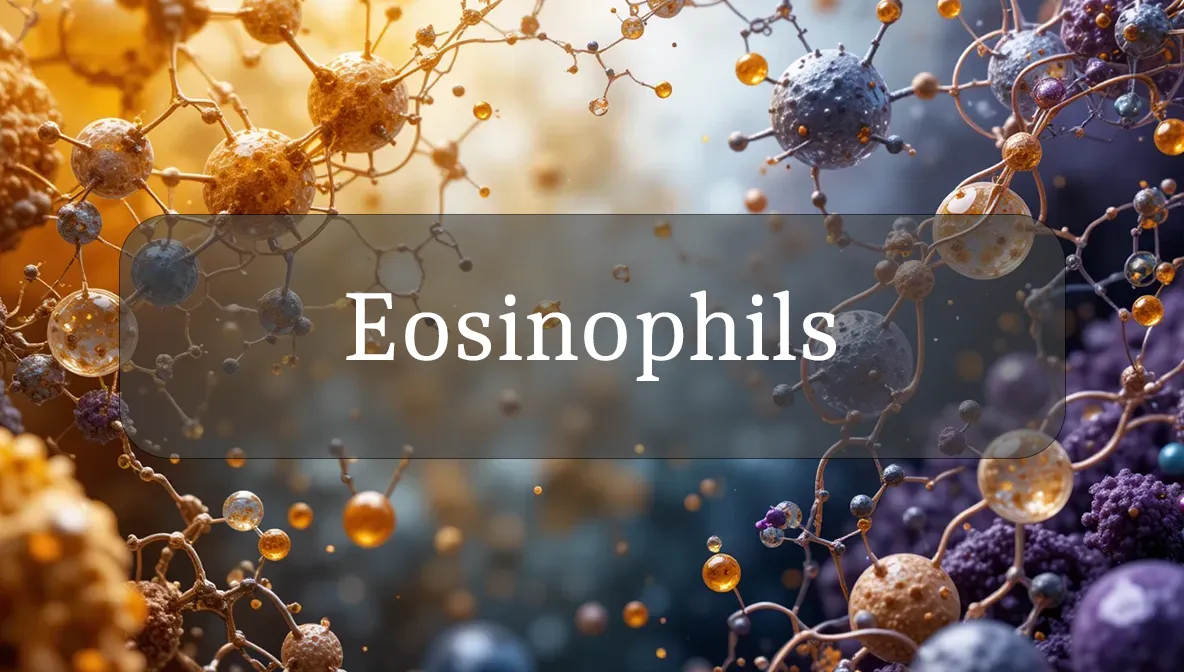Immune System’s Specialized Defenders Against Parasites and Allergies
Eosinophils are like the elite task force of your immune system, stepping up to battle parasites and manage allergic reactions with precision. These white blood cells, though few in number, pack a powerful punch in protecting your body from specific threats. For health-conscious folks eager to boost their resilience, understanding eosinophils can unlock insights into how your immune system keeps you safe and balanced. Let’s dive into what eosinophils are, why they’re vital for your wellness, and how to support their function for a thriving you.
Identity and Function
Eosinophils are a type of white blood cell, or immune system cell, formed in your bone marrow and released into your blood and tissues. Named for their bright red-orange granules (visible under a microscope with eosin dye), they make up 1–4% of your white blood cells. Eosinophils are equipped with proteins in their granules that destroy parasites, modulate inflammation, and respond to allergens. They patrol tissues like the lungs, gut, and skin, acting as specialized responders to infections, allergies, and immune challenges [1].
Immune Role and Benefits
Eosinophils are your body’s targeted defenders, with a significant impact on your health:
- Parasite Defense: They release toxic proteins to kill parasitic worms (e.g., hookworms), protecting your gut and tissues from infection [2].
- Allergy Regulation: Eosinophils manage allergic responses, like in asthma or hay fever, by releasing chemicals to control inflammation [1].
- Immune Balance: They fine-tune immune reactions, preventing excessive inflammation while ensuring threats are addressed [3].
- Tissue Repair: In some cases, eosinophils aid tissue healing, like in the gut or lungs, after infections or injury [4].
- Health Implications: Overactive eosinophils can drive allergic diseases (e.g., asthma, eczema) or eosinophilic disorders (e.g., eosinophilic esophagitis), causing inflammation. Low eosinophil activity may weaken parasite defenses, though this is rare [5].
Healthy eosinophils keep your body safe from parasites, your allergies in check, and your immune system balanced.
Ways to Support Function
You don’t consume eosinophils, but you can nurture their environment to keep them thriving:
- Balanced Diet: Vitamins like C and E (e.g., citrus, nuts) and selenium (e.g., Brazil nuts) support immune cell health [2].
- Hydration: Water keeps blood and tissues fluid, helping eosinophils move efficiently [3].
- Sleep and Recovery: Adequate rest (7–8 hours nightly) allows immune cells, including eosinophils, to recharge [4].
- Exercise: Moderate activity (e.g., walking or yoga) boosts circulation, aiding eosinophil function [1].
Dysfunction Indicators
Eosinophil imbalances can disrupt immune health:
- Dysfunction Signs:
- Persistent allergies, asthma flares, or skin rashes (from overactive eosinophils) [2].
- Difficulty swallowing or gut pain (e.g., in eosinophilic gastrointestinal disorders) [3].
- Frequent parasitic infections or unexplained fatigue (from low eosinophil activity, rare) [4].
- Causes: Allergens, infections, nutrient deficiencies (e.g., selenium or vitamin C), or toxins like pollutants can disrupt eosinophil function [5].
- Disease Link: High eosinophil levels are tied to allergic conditions, eosinophilic disorders, or some cancers (e.g., Hodgkin’s lymphoma). Low levels may signal immune suppression or bone marrow issues [3].
If you notice chronic allergic symptoms or gut issues, consult a doctor, as these may signal eosinophil-related concerns.
Promoting Optimal Immune Health
You can support your eosinophils with practical, everyday habits:
- Eat Immune-Boosting Foods: Include vitamin C (e.g., oranges, 70 mg per fruit), vitamin E (e.g., almonds, 7 mg per oz), and selenium (e.g., Brazil nuts, 68 mcg per nut) to support eosinophil health [2].
- Add Antioxidants: Berries, leafy greens, or dark chocolate provide cell protectors to shield eosinophils from stress or toxin damage [3].
- Stay Active: Engage in moderate exercise like brisk walking, cycling, or swimming (150 minutes weekly) to enhance immune circulation and eosinophil function [4].
- Limit Toxins: Avoid air pollutants, smoking, or heavy metals (e.g., mercury in large fish)—use air purifiers, filtered water, and choose low-mercury fish like salmon [5].
- Stay Hydrated: Drink 8–10 cups of water daily to support blood flow, helping eosinophils patrol tissues [2].
- Prioritize Sleep: Get 7–8 hours of rest to allow eosinophils to recharge, boosting immune balance [3].
- Manage Stress: Practice mindfulness, deep breathing, or meditation (5–10 minutes daily) to lower cortisol, which can disrupt eosinophil function [4].
- Avoid Allergens: Identify and minimize exposure to triggers (e.g., pollen, dust) to prevent eosinophil overactivation—use HEPA filters or hypoallergenic bedding [1].
No specific intake exists for eosinophils, as your body produces them, but a nutrient-rich lifestyle keeps them balanced.
Safety and Stressors
Eosinophils are safe as natural immune components, but certain factors can stress them:
- Stressors:
- Nutrient Deficiencies: Lack of selenium, vitamin C, or E can weaken eosinophil production or function [3].
- Toxins: Pollutants, heavy metals (e.g., lead), or chronic alcohol can impair eosinophils, increasing infection risk [5].
- Chronic Stress: High stress, poor sleep, or overexertion can disrupt eosinophil balance, skewing immune responses [4].
- Safety Considerations:
- Medical Conditions: Allergic or eosinophilic disorders require medical care, not just diet, and may need specialist monitoring [3].
- Environmental Toxins: Test well water for heavy metals and avoid polluted areas to protect eosinophil health [5].
- Medications: Corticosteroids (e.g., for asthma) can lower eosinophil counts, so follow medical guidance [2].
- Who’s at Risk? Those with poor diets, chronic stress, allergic conditions, or toxin exposure may face higher risks of eosinophil issues.
Fun Fact
Eosinophils are like immune snipers! Their glowing granules are packed with toxins so precise they can zap a parasite without harming nearby cells, like a laser-guided missile [1]!
Citations
- Alberts, B., et al. (2014). Molecular Biology of the Cell. Garland Science.
- National Library of Medicine. (2022). Eosinophils and Immune Function.
- Mayo Clinic. (2024). Eosinophilic Disorders and Allergies.
- National Institute of Allergy and Infectious Diseases. (2023). Eosinophils and Parasitic Infections.
- Centers for Disease Control and Prevention (CDC). (2023). Environmental Toxins and Immune Health.

